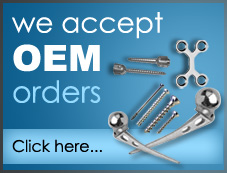
Disclaimer
The manual that follows is a tool to guidance and in no way intends to fulfill the purpose of training or even contradicting the same to any extent. The use of products manufactured at D4 Surgicals is primarily for all those who are professionals and are qualified, acknowledged and trained to do so. The use of all these products most importantly depends on the skills of the one using these. If unsure, do not use them by self but in fact ask for an expert assistance. Damages of any sort that may emerge due to improper handling and unauthorized usage are not something that D4 stands liable towards. Keeping the products and other materials away from the reach of children, animals and those unauthorized entities is solely an act that the owner will be responsible for and not us. Disposing off the materials in an eco-friendly way is also what the owners stands responsible towards. For products recalls a proper record of the same will prove helpful. Rest disputes of any sort are subject to the Court of Mumbai Jurisdiction.
Disclaimer Notice: All our products are restricted to uses by surgeon or professional who are qualified and trained to use it. The company is not liable for any damages or detriments due to improper or unauthorized usage. It is your responsibility to keep the products & packing away from the reach of unauthorized people. User/Consumer must always refer to the package insert, product label and/or instructions for use before using any our product. All disputes are subject to Mumbai Jurisdiction.
Disclaimer Notice: All our products are restricted to uses by surgeon or professional who are qualified and trained to use it. The company is not liable for any damages or detriments due to improper or unauthorized usage. It is your responsibility to keep the products & packing away from the reach of unauthorized people. User/Consumer must always refer to the package insert, product label and/or instructions for use before using any our product. All disputes are subject to Mumbai Jurisdiction.
- Patient selection: The points that should be considered during this
- Degenerative Diseases: Patients who are suffering from degenerative disorders of any sort may suffer from early rejection of the implant that may prove not so effective and in all such patients surgery is the only solution that can provide temporary relief to the one suffering.
- Immunological Intolerance: There are some patients who may develop immunological tolerance to material; performing foreign body tests can thus be helpful in knowing the same before undertaking any tests
- Alcohol and Drug Addiction: Also, people suffering from drug or alcohol abuse are intended to overlook the stage of withdrawal or stupor due to lack of proper care where the chances of failure of implants are highly enhanced.
- Mental Illness: Development of complications and even implant fractures can occur in case of patients ignoring the limitations and precautions they should follow after an implant, to which patient suffering from mental illness or schizophrenia are the most vulnerable.
- Obesity: Failure of an implant is very likely to occur in patients who are suffering from obesity where an increased load and abnormal stress can prove a triggering factor to the same.
- Activity: Patients who undertake vigorous muscular strain in the area where the implant has been preformed are also at high risks of suffering from implant failures.
- Degenerative Diseases: Patients who are suffering from degenerative disorders of any sort may suffer from early rejection of the implant that may prove not so effective and in all such patients surgery is the only solution that can provide temporary relief to the one suffering.
- Implant Selection: In order to call the implant a success, the selection of the implant plays a vital role, where the size, shape and design all play a vital part. The size and also the shape of the bones in human acts like a limiting factor on the strength and the size of the apt implant during a reconstructive surgery or fracture management in patients. The implant that the surgeon or Orthopaedician chooses must be free from any manufacturing defects and any apparent corrosions to give the best and desired results.
- Unstable: Insufficient support and an unstable implant fixation can cause the plates that are fixed to break and fatigue even if proper bending was performed. In order to avoid any such dilemma, that may occur in terms of screw loosening and necrosis in an early stage, the screw should be properly centered. To easily overcome the countersink of the plate avoiding the same to get forced on one side and also avoid damage of the good threads in the bone and development of strain of any sort.
- Implant Removal: In patients who are young and more active, the implants are removed after the process of healing is completed and after it has perfumed the desired services for this the decision of the surgeon is very important.
- Implant Handling: For apt implant handling, the implant must conform to the shape of the actual bone and any inequality should be adjusted in order to get the accurate plate shaping before the procedure is carried out. The use of screws to bend the plate is never recommended for the strong expelling force inside the body can cause an instant damage to the plate. The plate benders that are crafted for this very purpose must thus be used for any such plate contouring. Also, make sure at the screw hole there should not be any scratches, distortion notches or sharp dent of any sort. The presence of any such defect can cause improper bonding or defect in the surface finish of the implant.
- Second Hand Implants: The implants that have already been used may have damages that may occur in the form of internal or external defect, which even the stress analysis of the individual parts may fail to reveal, that may have incurred due to their presence within the body. This if overlooked, can cause implant failure. Thus, implant after use must be discarded and reuse must not be performed ever. Proper disposing is also required in order to protect them from causing any damage to the stray animals, children and even to the environment.
- Post Operative Care: Postoperative care is very important and making the patients aware of the limitations and precautions of handling the metallic implants is necessary. In case of an ununited fracture, no non-weight or partial weight bearing devices can withstand the excessive muscular activity. In order to accomplish the bone union, restriction of activities is a necessity to help in the process of apt healing.
- Incompatible Combinations: Use of implant components from one manufacture must not be used with another for the design and metal that different manufactures use may be different. So, to avoid the generation of peizo currents that may occur due to inadequate fixation and corrosion, implant components from one should not be used in conjunction with the other.
- Packaging Disposal: The material that is used for packaging of the devices if swallowed can cause hazards of choking, thus proper disposal is advised to keep the same out of reach of animals and children.
- Sterility: The perfect sealing and untampered care of the same can help the device stay sterilized up to five years from the date of manufacturing as per the laid standards of the International policies. Thus, the end user before using the device must check this thoroughly, which is mentioned even on the sticker packed on the device. In case of improper packing and imperfect sealing, the device should be considered non-sterile and a proper sterilization must be followed. The valid steps of sterilization entail the device being sterilized by the method of steam sterilization, that involves sterilizing this at a temperature of 121º C at 15 psi steam pressure for a duration of 25-30 minutes.
- Use: For best use, the devices should be used only by surgeons who are qualified and trained to handle the same.
| Enquiry | Sitemap | Disclaimer | Related Links |



|
| Copyright © reserved by orthopedic-implants.net, a division of D4 Surgicals of India |












